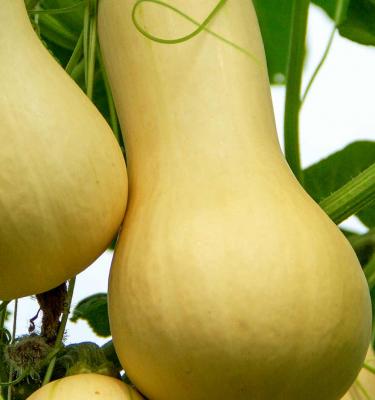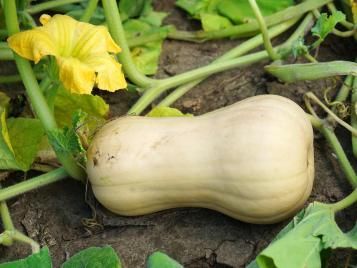

How to grow butternut squash
Butternut squash are a late season favourite, with attractive fruits which will keep well throughout the autumn and winter. The flesh is a deep orange colour, and the flavour warming and gently sweet. Growing them in the UK is straightforward and very satisfying - let’s look at how to grow this rewarding plant.
Squashes are grown as annuals in Britain, and are classified as either summer- or winter-squash. The seeds of both are sown in late spring.
Butternut squash is a type of winter squash, usually harvested from September onwards, and brought indoors to mature before the first frosts arrive. Winter squash such as butternuts are excellent for storing and will keep for up to six months in the right conditions.
Summer squash, such as courgettes, are grown to be used straight away. The skins do not thicken in the same way that winter squash skins do. The fruits are more prolific and quicker to grow, taking as little as 10 weeks from sowing to harvest. Winter squash have a longer growing period, needing four to five months from sowing to harvesting.
The botanical name for butternut squash is Cucurbita moschata. They are also known as butternut pumpkin, and gramma. Some of the varieties worth trying include:
- Butterbush F1. Unusually for butternut squash, this one is a compact variety which has more of a bush habit. Great if short on space, this one can be grown in containers.
- Butterscotch. Produces small fruit, this one also has more of a bush habit, making it great for containers.
- Harrier F1. Slightly paler skin than other varieties, this one will produce fruits that store very well.
- Hunter. Produces lots of small fruit which will store well.
- Sweetmax F1. A good one for the climate of the United Kingdom, this variety flowers early, giving the fruits longer to mature.
- Tiana F1. This one produces lots of smaller fruits weighing about 1kg each, so expect great flavour.
- Waltham. Stores very well and has a small seed cavity, meaning more flesh to eat!
If your interest has been piqued by the wonderful butternut squash, have a look at other types of winter squash. There are spaghetti types, which have stringy flesh just like pasta of the same name. There are also some with dramatic skin, such as the polar white pumpkin, and the orange and yellow speckles and stripes of the ‘blaze’ variety. There are then of course the traditional pumpkins, available in various shades and sizes.

What you’ll need to grow butternut squash
Although seed packets say that butternut can be sown from March onwards, they need warm overnight temperatures. They are quick to germinate, so a sowing in late April or May will soon catch up, without the worry of protecting plants from cold weather.
To grow butternut squash you will need:
- 12cm (5") pots.
- Compost.
- Butternut squash seeds.
To sow the butternut squash seeds:
- Fill pots with compost.
- Place one seed in the centre of each pot, gently pushing it into the compost so that the ‘sharp’ long edge faces upwards, about 1cm (½") deep.
- Water, and move to a warm place, such as a windowsill or greenhouse.
Once seeds have germinated and are showing three or more leaves, or if you have bought plants, they can be planted outside. This will be in May or June, once the risk of frost has passed. You will need:
- Garden fork.
- Compost, manure or other organic matter.
- Trowel.
- Butternut squash plants.
- One cane or stick per plant.
- Work in plenty of organic matter using the garden fork, to each spot where a butternut squash will be planted.
- Use the trowel to create a hollow mound in the soil. This is so that the hollow will retain water rather than it running off.
- Dig a hole in the middle of the hollow, big enough for a butternut squash to be planted.
- Fill the hole with water. Once it has soaked in, remove the plant from the pot and place in the hole, backfilling with soil and gently firming in.
- Insert a stick or cane in the hollow, close to the plant, so that it is easy to see where to water once the plant puts on leafy growth.
Look out for large yellow flowers which will be enjoyed by bees as they visit to pollinate the butternut squash plants.
Where to plant and grow your butternut squash
Butternut squash prefer hot, humid conditions, so ideally plant out in a sunny spot away from cool winds. They like rich soil, so add a suitable compost to the soil before planting out. Feed regularly with Miracle-Gro® Performance Organics Fruit & Veg Concentrated Liquid Plant Food.
Butternuts are usually vining plants and can be left to sprawl across the ground, or trained up supports. Allow 1.5 metres (5') between plants. The fruits can easily reach 3kg, so if they are allowed to climb, make sure each hanging fruit is propped up with strong supports to stop it snapping from the plant. Bush varieties, grown in containers, are the exception as they need less space - allow 1m (3’) between plants.
Caring and nurturing for your butternut squash
British weather is quite temperamental, so be prepared to protect early sowings. Monitor night-time temperatures in the weeks after they have been planted out, and if temperatures are forecast to fall below 12°C (54°F) overnight, place a cloche or fleece over them.
Once fruits have appeared, feed fortnightly with Miracle-Gro® Performance Organics Fruit & Veg Concentrated Liquid Plant Food. Butternut squash are hungry plants will benefit from a plentiful supply of nutrients. Water regularly for larger fruits.
In early September remove any leaves shading young fruit, so that the sun can reach the skin to ripen it. Allow butternut squash to ripen on the plant if possible.

Harvesting butternut squash
Butternut squash are ready to harvest from September and October onwards, when the skins lose their greenness and start to turn orange. Squash must always be harvested before the first frosts. The skin should be hard and difficult to push a fingernail into.
Using a sharp pair of secateurs, cut the butternut squash from the plant, leaving 15cm (6") of browning vine either side of the top of the squash. They can be used straight away, but the flavour will develop more if left to cure.
Always handle butternut squash by the bottom of the fruit, and not the stem, however tempting it is to carry them by what looks like a handle. The attached vine acts like a seal on the fruit, stopping bacteria from reaching the flesh.
Once in storage, check the skin of the squash near to the stem every fortnight. Look out for darkening or soft patches, which indicate that the fruit is starting to spoil and should be used. Store at about 10-15C (50-60F) in a ventilated place.
Common pests and diseases with butternut squash
Butternut squash plants are very resilient to most pests and diseases. As mentioned earlier, they do like warm weather, and a cool summer can limit the amount of fruit produced. This is somewhat uncontrollable - just wait for warmer conditions to arrive.
Slugs and snails. Will attack young plants and can kill them completely. Encourage frogs, toads and hedgehogs, which will eat these predators. Try placing crushed eggs shells, coffee granules or copper coins around plants to deter them.
Powdery mildew. Very common on all types of squash, appearing as a white powder on the upper surface of leaves. Unattractive and reduces the vigour of plants. Avoid by keeping plants well watered, and remove any infected leaves from the plant.




